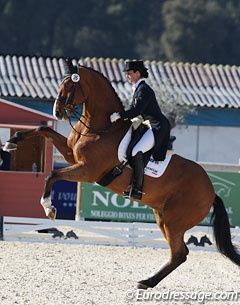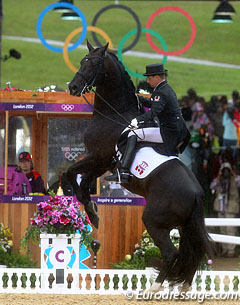
In a test there are a thousand and one things that can go wrong. Watching the world's top dressage riders, it seems as if they can pull together an accurate test time after time and it leaves us mere mortals wondering what the hell we are doing wrong. Perhaps it isn't that they have a special secret, more likely it is that they have made all the mistakes before and have learnt never to make the same mistake again!
After a thousand tests you can limit the potential for common error! The typical and most obvious mistake a rider can make is to forget the test. We've all been there, sailing on down the long side past E and suddenly remembering that the diagonal we were suppose to take started all the way back at K!
The other even more frustrating test error is walking out of the arena and thinking: "What did I actually do in there?" I call it, the "forget to ride" syndrome, when you realise you simply just floated around looking pretty, but didn't really do much else!
I've also had a horse jump out of the arena, break in the extended trot, piaffe/jig jog in the walk, step back in the halt: all signs of tension and or lack of rider/horse concentration. The other broader competition errors happen before we even get to the arena: not allowing enough time for the warm-up or allowing too much time for the warm-up.
These mistakes become test dilemmas and become evident in the fly-around-out-of-control or the stay-awake-if-you-can test varieties. However, the thing to remember is that most of these mistakes stem from a lack of preparation. When my horse gets excited in the arena before the test's completion it was my own fault for not setting him up in the corner, not keeping my outside rein solid, and not maintaining his balance through the relaxation and effectiveness of my seat. Mostly, I stopped riding for a few seconds and he knew.
Horses know it is competition time and while some horses work better, and have a personality that says "look at me!" others decide this is a great time to test you, knowing that you can't properly discipline them in the test environment. I argue that unless it is the Olympics, you should correct the horse because, like a child, everytime he gets away with it, it is one more time he has won! If you are jig jogging in the walk and he is trying to take charge and not listen, stop, make him wait, and then return to the movement slowly.
 Shying in the test is another common test dilemma, but the most important thing here is not to make a big deal out of it. The second your horse shies, god willing you remain in the saddle, you should think one thing: rhythm. Just get the rhythm back and that way you can hopefully return to the test as quickly and with as little disruption as possible!
Shying in the test is another common test dilemma, but the most important thing here is not to make a big deal out of it. The second your horse shies, god willing you remain in the saddle, you should think one thing: rhythm. Just get the rhythm back and that way you can hopefully return to the test as quickly and with as little disruption as possible!
With the "forget to ride" dilemma it can be triggered by various things. Sometimes you have such a brilliant warm-up that you sort of get lazy and just float around in a haze of "well it was all going so well!" Other times you can begin the test really well, on the ball, sitting up, really riding and then something goes wrong and you loose your act completely. For example, I have just taught my young stallion the flying changes, and being a Mr Look-At-Me variety, he of course got in the test and wanted to show off his new trick! The second I went to the canter, I could feel him saying "when... when... when?" and sure enough, the minute I lost just the slightest bit of balance on the counter canter corner, he changed, and worse, because he knew I didn't ask for it, he did a nice kick up in the air after in celebration of his effort!
What I should have done immediately after this dilemma was sit back, firm my seat, open up my chest, and reinforce the power and effectiveness of my canter aids. Instead I fell slightly forward, lost the effectiveness of my seat in the canter and became a passenger for the remainder of the test.
The other test dilemma is when the horse gets in the arena and won't let you ride him. To the onlooker it may not always be obvious. There is of course the complete in the air disasters, but I'm talking about the horse that subtly locks in the back, stiffens through his neck and says, "I am just going to stay here and be really still and maybe she won't make me do anything!"
Trying to soften becomes like trying to loosen an iron bar and the leg aids become like tiny batons on a brick wall. This is more difficult to fix and whilst you may be able to make it safely and respectfully up the centerline, trying to achieve a working shoulder-in on a stuck horse is more difficult. Because you are in the test, you can't really pull your hand out to the side or do small circles in bending to relax him, so you have to find an effective, yet well disguised way of getting him to soften. This means work with your hands forward and relaxed. You must work work work all the time, little check and gives, continuously relaxing the jaw and telling him that you need him to be supple. You cannot do it once and then stop, but must continue through the test, creating little waves of energy through his body to keep the energy flow moving. The minute you stop or pull too hard, he will lock against you more and get even more stuck! These continual and subtle relaxations will help you get enough movement in his body to at least allow you to carry out the movements of the test.
 The most important thing to remember, when aiming to avoid test dilemmas, is not just to ride and prepare, but to use your corners. It sounds so easy and you think “yeah yeah, I know, just go into my corners,” but it is more than that. Corners are like the golden triangle in which you can not only sit a horse back, balance him, control the rhythm, engage the hindquarters, and improve submission, but it is also the place where you can soften and re-establish the correct bend and suppleness of the poll. You should not just go deep in the corners, but think of riding the corners in shoulder-in, creating bend, then using your inside leg aids to engage the horse into the outside, while your outside aids act like a wall to reinforce and prepare for the straightness as you make your way back onto the long side!
The most important thing to remember, when aiming to avoid test dilemmas, is not just to ride and prepare, but to use your corners. It sounds so easy and you think “yeah yeah, I know, just go into my corners,” but it is more than that. Corners are like the golden triangle in which you can not only sit a horse back, balance him, control the rhythm, engage the hindquarters, and improve submission, but it is also the place where you can soften and re-establish the correct bend and suppleness of the poll. You should not just go deep in the corners, but think of riding the corners in shoulder-in, creating bend, then using your inside leg aids to engage the horse into the outside, while your outside aids act like a wall to reinforce and prepare for the straightness as you make your way back onto the long side!
In truth though, the best way to avoid making test dilemmas, is to learn from doing them. The top riders probably didn’t just arrive at perfection and more likely than not they have just done it all before and learnt each time never to make the same mistake twice. After that one time the horse flew out the door, they instinctively knew to always maintain a strong outside aid when passing the opening, etc.
It became clear to me that the top riders learn by experience when Edward Gal told me about his first ever vet-check, when he rocked up with the horse fully bandaged, looking stunning I am sure!
Test dilemmas are there to teach us, to remind us what we need to incorporate into our training and while professionals make it look beautiful and simplistic never forget they have done it a 1000 times, and probably made 1001 mistakes along the way.
by Sarah Warne
Photos © Astrid Appels